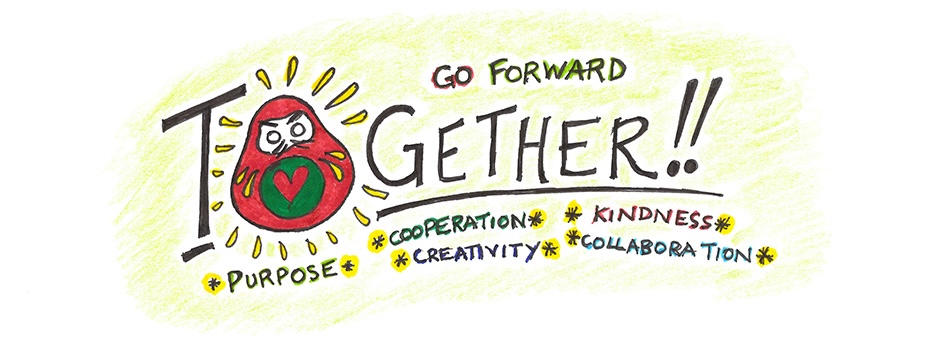Some people might find it strange that we (Katie Anderson and Karyn Ross) work together so often. After all, we each own our own companies and work in pretty much the same space: coaching, consulting, and helping organizations create better ways to work using lean principles and practices. Aren’t we the “competition?” Shouldn’t we be vying with each other?
We don’t think so. For the past year, we’ve actively worked to create new ways to serve others based on cooperation, collaboration, kindness, and creativity. Why? Because our lean principles teach us that we don’t have to rely on old ideas and old ways of doing things. As Sakichi Toyoda reminds us in the second of his five precepts: “We should always be studious and creative, striving to stay ahead of the times.”
As we all grapple with ongoing changes imposed by the COVID-19 virus, we have an opportunity to reflect deeply and thoughtfully on what we choose to take forward with us – the practices and ways of being and working that were good, positive, and useful. In reflecting, we can also select the approaches we want to leave behind, whether they served us in the past but do not fit in our new reality, or were just “how things have always been done” even though they did not serve us well. This time of change is our opportunity to create new ways to bring value and benefit to people, animals, and our planet.
Here are our reflections on what we’ve learned working together and see as important for those in the lean community to consider as they create a way forward to a new, better future.
Don’t just think about “going back”
There are many good things we can take from the past. Principles like respect for humanity, “go see,” and flow. However, if we think only about “going back,” we will miss our opportunity to go forward into a better future. And isn’t that what kaizen is all about? Using our lean principles to create a better way? So, how can we respect and learn from the past and create for the future?
Connect with purpose and align your actions
People often say, you two are so different from each other! Yes, we have different personalities and different backgrounds and even different specific purposes in life. However, while each of our purposes is unique, we share a uniting core that has enabled our partnership. We have found that connecting with our shared purpose of helping people – of focusing on creating value and human connections as our priority – has enabled us to be even more creative about adapting to our new reality. We encourage our clients and K2C2 community members to define their purpose so that they can use it as a “north star” guide for their actions and plans. With a clear purpose, we can navigate our way through the unknown.
Focus on cooperation and collaboration
One of the things that we’ve learned during our collaboration (and we’ve taken it as our mantra) is that 1 + 1 = way more than 2! Bouncing ideas off one another, coming up with quick ways to test them out, and then reflecting together has helped us quickly create new ways to help people, like K2C2 – Karyn and Katie’s (or Katie and Karyn’s) Coaching Community of Practice. After Katie visited Karyn last April, we saw a need, created the first test, tried it out, and, a year later, have had five successful cohorts and a coaching intensive. We’ve learned so much from our community members because, as it turns out, 1 + 1 + 1 + …. = way more than anyone could have ever imagined! Cooperating and collaborating has enabled us to help more people, benefited both of our businesses, and has been unbelievably fun and rewarding!
How we get there is just as (or more important) than where we are going
Consultants and businesses often focus on the ends of the business rather than how we serve our customers. “What growth will it bring to my business?” “What is the impact to the bottom line?” and “What productivity gains will we realize?” As we go forward, what if we focused on the means – the process or the “how” we get there, not the end goals.
What if we really focused on it – how we provide value to our customers – as our lean principles say that we ought to? As we’ve learned, using our Right-Sized-Pricing approach leads to the best kind of results! With this approach, clients pay what they can afford, and we focus on the means – creating a community of practitioners where every person is valued as an important contributor regardless of their level of expertise. We get results such as:
- an active, engaged, and vibrant group of learners who inspire and teach us through their diverse experiences
- “customers” who have grown as leaders, coaches, and people
- good business results – including many recommendations for other work and new community members for future cohorts!
Be Creative! No ‘I can’t’s’ here!
When we started K2C2, all we knew was that we wanted to create ways to work together and create a strong community of thoughtful, confident practitioners. We certainly didn’t know how to do that. So, we had to do what we teach people: set your target, list down all the reasons you think you “can’t,” use divergent thinking to come up with as many ways that you ‘could,’ and quickly try them out. PDCA. This approach is an artistic process, as well as the scientific method. Through creative PDCA we’ve found ways to welcome people from time zones all over the world to our community, to blend our two methods and styles, and to adapt K2C2 for changing conditions, such as people working from home during a pandemic with all family members around. During our K2C2 Intensive, we encouraged people to bring their children, and we provided creativity activities for them to do! Why not? PDCA means creating new ways as conditions change.
Be Kind
Last, and definitely not least, we’ve learned that going forward means creating with kindness – kindness to people (including ourselves), animals, and our planet. You are kind when you:
- ask questions that come from a place of genuine curiosity and caring
- listen to what others have to say with open eyes, open ears, open mind, and an open heart
- value and try out ideas to see what happens even if you don’t necessarily think they will work
- focusing on helping first and on “competition” and dollars second.
Because going forward means creating a world in which everyone is a valued and valuable part of our community; what ‘respect for humanity’ is truly all about. Going forward means balancing nurture with challenge.
As we all go forward together, we hope that you will take the time to thoughtfully and deeply reflect on the past. And then ask yourself the following questions as you ‘create forward’:
- What is your purpose?
- What worked well for you in the past? What didn’t work?
- What do you want to keep from the past?
- What do you want to change for the future?
- How can you apply lean principles today – as you create for the future – without holding on to what might have worked in the past?
- What must you let go of to move into the future?
- What must you create?
- What ways can you demonstrate kindness – to yourself, others, animals, and the world?
- What is holding you back? What are your “I can’ts”?
- How will you go forward?
- What future do YOU want to create?






